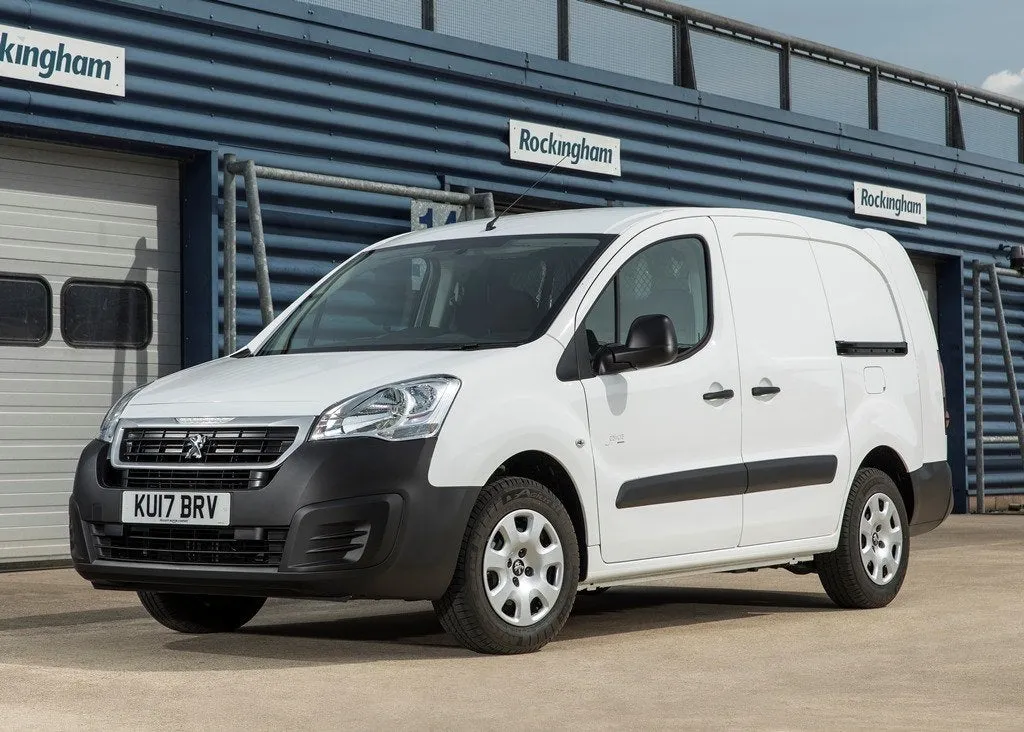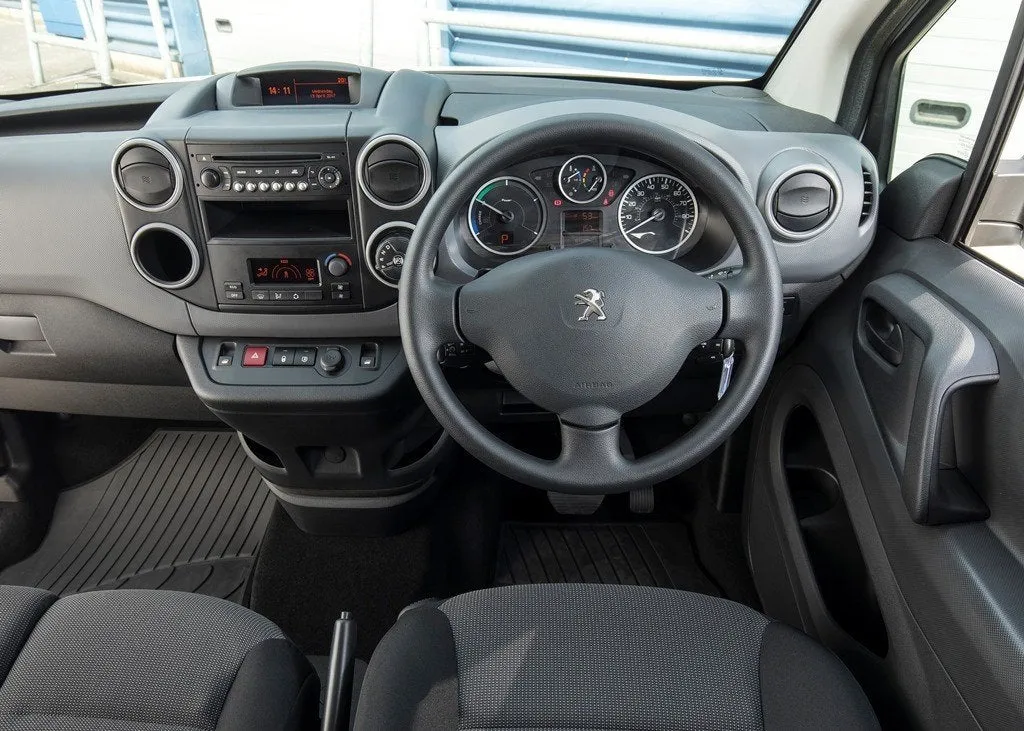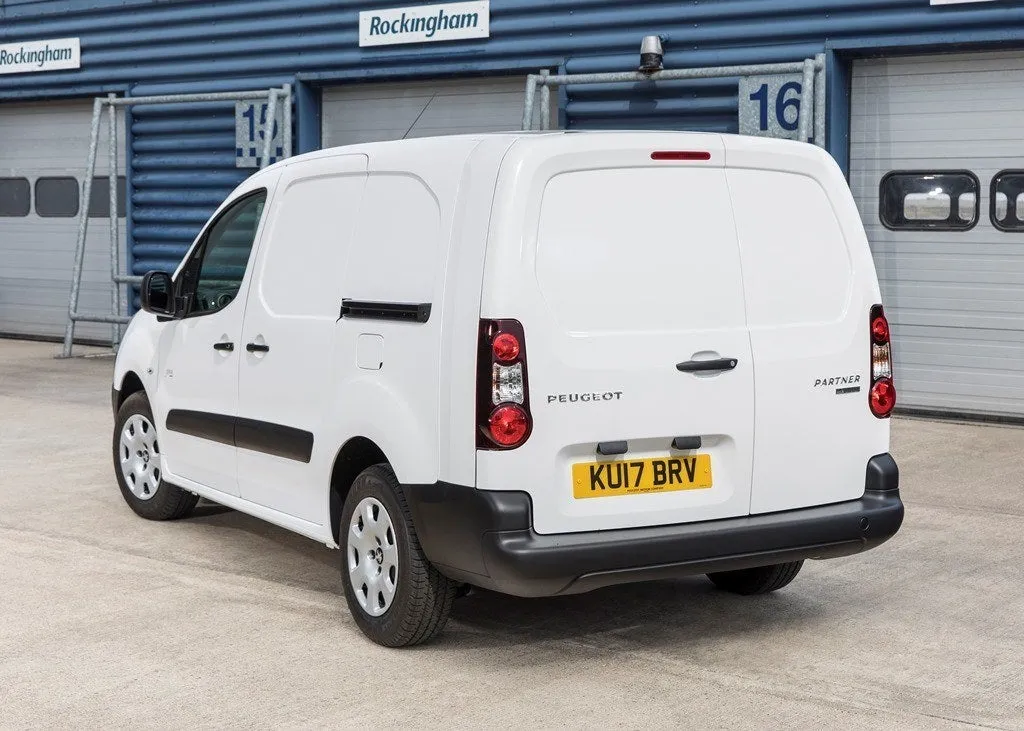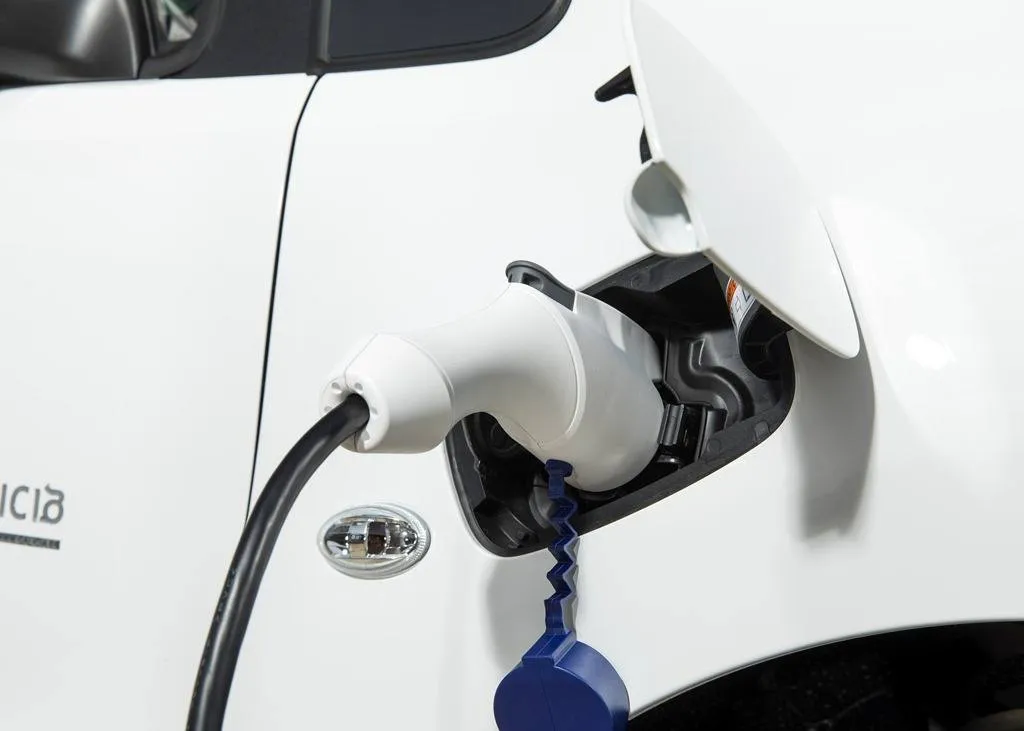Peugeot Partner Electric (2017-2022) Review
Written by Andrew Brady
Quick overview
Pros
- Quiet and easy to drive
- Low running costs
- Affordable versus rivals
Cons
- Limited range
- Poor equipment levels
- Dated cabin
Overall verdict
"Long before electric vans became an important part of a brand’s future, the Peugeot Partner came with a battery-powered version. There were no major changes to the standard diesel-powered model, which brought both benefits and drawbacks for those choosing to go electric."

The major benefits are the obvious ones – the Partner Electric is able to go in and out of major city charging zones for free, it enjoys exemption from VED and it doesn’t produce any tailpipe emissions.
It is available in two lengths, the same L1 and L2 models as the standard Partner, although its practicality doesn’t quite match up on all fronts. The payload, for example, is somewhat lower than the equivalent on the diesel Partner, at 552kg for the L2 and 636kg for the L1 – down somewhat on the 860kg of the direct diesel equivalent.
It’s worth noting that the Electric version is based on the Partner that was on sale from 2008 to 2018. The model that replaced it has a higher payload still, and the promised electric version should boost the payload too.
However, the rest of the Partner Electric’s practicality is to be commended. The batteries sit flat under the load floor and don’t hinder the loading space so you get the same space in the back as you do in a standard version. This means a 1.22m gap between the wheelarches and up to 3.7 cubic metres of room.
The Partner Electric has the added bonus of being able to carry three passengers up front, too, and it offers a touch more room than the diesel model for the middle seat too. This is because of the lack of need for a conventional gear lever or handbrake. The Partner isn’t a huge van, though, so it is still a little cramped in terms of shoulder room, but the little extra helps.
Because the Partner Electric is based on an older model than the rest of the Partner range, the rest of the interior feels slightly dated, with equipment levels relatively sparse. There is no DAB digital radio for example, and no Bluetooth.
The simplicity of the cabin means that everything is fairly straightforward, though, with a clear battery meter and a dial that shows when the battery is draining and when it is managing to claw some charge back through braking and the like.
The fundamental driving experience of the Partner Electric is a very relaxing and enjoyable one. Like all electric cars there is no need to change gear, and it is smooth and stress free around town in particular. It’s wonderfully quiet, too, with next to no noise from the motor with only a little hum that you won’t be able to hear over the general wind and road noise that comes with driving any vehicle.
As with many electric vehicles, the range is an issue for the Partner Electric, and it only promises an official maximum of 106 miles. Even Peugeot concedes this is unlikely, though, and something around 80 miles or so is more likely, or less if you are going to load up the payload or it’s winter or if you drive at a higher average speed.
High average speeds will be tricky, though, as the Partner is limited to 68mph, further underlining how this is a vehicle best suited to the town.
Is the Peugeot Partner Electric right for you?
If you are after a small electric van then the options are few, with the Nissan eNV200 and Renault Kangoo Z.E. 33 the major rivals to the Partner Electric.
Where the Partner Electric has a real advantage is price, with the basic model notably cheaper than the likes of the eNV200 and the even more expensive Kangoo Z.E. 33.
You don’t get much in the way of kit for your money, and the range isn’t as strong as the Renault and Nissan, but if you have a short and predictable daily routine with easy access to night-time charging then the Partner is a strong budget option.
What's the best Peugeot Partner Electric model/engine to choose?
Choosing a Partner Electric is fantastically simple – there is just the one trim, engine and gearbox available. It comes in SE trim only, which is relatively sparsely equipped. There are a few optional extras that could be added – Bluetooth, DAB and satellite navigation for example – but you can’t spec your own new Partner Electric so you are reliant on Peugeot or a previous owner having added those extras.
The only other thing you can pick between is the two lengths – L1 or L2. There is no difference between the two in terms of range etc, so that really comes down to personal preference.
What other cars are similar to the Peugeot Partner Electric?
The small electric van class is growing all the time, but the main contemporaries to the Partner Electric are the Renault Kangoo Z.E. 33 and the Nissan eNV200. They offer a better range and a better payload, although only by a small margin, but are more expensive with it.
The Citroen Berlingo Electric is fundamentally the exact same vehicle as the Partner Electric, just with a different badge. The new model of the Partner and Berlingo Electric will be joined by the battery-powered versions of the Vauxhall Combo and Toyota Proace City.
Comfort and design
"The Peugeot Partner Electric’s old-fashioned status aids it in a way when it comes to the space and comfort in the cabin. The simplistic layout means that there is plenty of head and leg room, while the steering wheel can be adjusted for reach and rake so you can get into a comfortable position relatively easily."

The seats themselves are fairly firm which means they are supportive throughout a long day behind the wheel. There are three seats as standard but the Partner Electric’s dashboard design means that it offers more in the way of comfort for the middle seat passenger than the diesel model. The actual seat is slightly harder, partly because it is a little narrower than the other two, but it does get a decent amount of legroom as the dash doesn’t have to accommodate a large gear lever.
Instead, the van is shifted from neutral to drive via a small dial that is positioned up on the dash. At a quick glance it looks more like a dial that would be used to adjust the cabin temperature, it’s that small and tucked away.
The rest of the dash is simple enough that there is no mistaking what the various elements are supposed to do. There is no fancy navigation or infotainment system around which the dash is centred, so there are just a few basic buttons and an old-school stereo and simple air vents.
Because the Partner’s original design dates back to 2008, which is a long time before the small steering wheel that features in the latest models first appeared. This means that you get a conventional and plain steering wheel with no buttons on it and very little in the way of decoration.
This means it is incredibly easy to navigate your way around the various functions while you are on the move. The driving information in front of you is clear and simple with a dial that shows whether the battery power is being used up or if it is reclaiming some charge through brake regeneration. There is also a small dial that shows how much charge there is left, in a style similar to a fuel gauge.
Quality and finish
Attitudes towards the plushness of a van’s interior have moved on somewhat since the Partner was first launched in 2008, so the Electric’s cabin feels more than a little dated as a result.
The plastics on display are fairly uniform and there is little in the way of variety to break up the look and feel of the interior – certainly there are no touches of chrome or different coloured plastic as there might be on more modern rivals.
As there is just the one trim in the range there is no chance of adding a touch of premium by splashing out a bit more cash. The version you get is the only one on offer. Instead you get dull, hard and scratchy materials that don’t inspire much. Despite this old-fashioned look and feel, the Partner Electric’s cabin does feel like it is robust and suited to taking on a few bumps and dents.
Infotainment
Infotainment doesn’t feature heavily in the Peugeot Partner Electric, with the basic stereo on offer not even coming with DAB digital radio, which is pretty much a given on all vehicles in the small van class. It doesn’t even have Bluetooth as standard, so streaming digital radio, or your own music etc, through the speakers isn’t possible either. Both of these could be added on as options, but you can no longer spec your own Partner Electric so there is no opportunity to add it in any more.
The radio and the LCD screen looks even more dated than it sounds, and it looks more suited to a car from the 1990s. Suffice to say that Apple Carplay, Android Auto and the like are not possible either so an aftermarket navigation unit is your best bet.
Space and practicality
Passenger room in the Partner Electric is decent, with enough width to squeeze three across the front. The one in the middle will definitely have drawn the short straw as the seat is narrower than the other two, so it’s not a full-time option. The extra legroom created by the lack of gear lever is handy, but it still isn’t a seat you’d want to spend hours in.
The load space in the Partner Electric is the same as you get in the conventional models of its generation. It also comes in either L1 or L2 models, although the latter was only added towards the end of the Partner Electric’s life, joining the range in 2017.
The battery position is the reason for the loading space being unchanged as they sit underneath the load floor. This means that you get the same 1380mm overall width and 1230mm between the wheel arches.
The shorter of the two offers a load length of 1800mm while the longer stretches this out to 2050mm. This can be extended to a maximum of 3250mm if you get a model with the Multi Flex passenger seats. These fold forward and allow you to slot longer items into the front part of the cabin.
Because of the extra weight that batteries add, the payload of an electric van is often compromised versus a conventional model, and so it proves with the Partner Electric. The maximum carrying ability is reduced to 636kg in the L1 model and just 552kg in the L2, so those longer loads had better be light. The standard Partner of this generation was able to carry up to 860kg.
There is a slight difference to the doors on offer, with the L2 getting two side sliding doors while the L1 only gets one. Both get twin asymmetric rear doors that open out to 180 degrees. The ability to tow is another trick that the standard model has over the Electric – you can’t tow at all with the Electric model.
Handling and ride quality
"The standard version of the 2008-2018 Peugeot Partner rightly won plaudits for its car-like handling, with this being one of the reasons behind its enduring popularity. The Electric model, in some senses at least, is even more enjoyable and rewarding to drive. "

It is most at home in urban areas. It’s 11m turning circle and relatively compact size means it is perfect for slotting into tighter areas of town, while the steering is nice and light, meaning that it takes little effort to pull off those low-speed manoeuvres.
The batteries being positioned under the loading bay has benefits in ways other than just practicality. By being down low, they lower the centre of gravity and mean that corners can be taken with more confidence and pace. This helps keep body roll in check, to a greater degree than the standard model even, which was already a composed van when it comes to corners.
This is further aided by the supple suspension, which manages to keep the ride smooth even when there isn’t a load in the back of the van.
You can take the Partner Electric on the motorway, but the pace at which the battery charge disappears when you get up to speed will probably put you off doing so too often.
Engines and gearboxes
There is just the one battery version of the Partner Electric available, so it’s the 49kw (67PS) model or nothing. This does, however, make it slightly more powerful than the 60PS Renault Kangoo Z.E. 33.
As is the case with EVs, the motor gives an instant reaction when you put your foot on the accelerator, with the immediate torque making it pleasingly nippy away from a standstill. This doesn’t translate into a sustained level of acceleration, though, and the Partner Electric’s pace is somewhat more pedestrian when you are already moving at faster speeds. It’s not up to blasting past slow vehicles in rapid overtakes, and its forte is the first few metres of a journey.
The gearbox is incredibly simple. You turn a dial on the dash to select drive or reverse and that’s it – the Partner only has the one gear, so there is no mucking around with jerky changes or a clutch pedal.
The braking is the big thing that sets the Partner Electric apart, though. When you lift your foot off the accelerator, the Partner seeks to recover energy by engine braking. The process is quite aggressive, which can mean that there can be a bit of a jerk if you abruptly lift your foot after a burst of fast acceleration.
The process takes a little mastering, but it allows you to control the pace of the van without touching brake pedal as often. The engine braking won’t bring you to a total halt, but it will suffice for the majority of the time, meaning you should save on brake replacement costs, too.
Refinement and noise levels
Refinement is a real high point in the Partner Electric. There is no noise at all from the motor when you turn the van on and barely any when you set off either. There’s a mild hum at best, but you are hard pushed to hear that even when you get up to anything above crawling speeds.
As well as noise, diesel engines are also responsible for a large amount of the vibration that you get in a van, too. It follows, therefore, that the Partner Electric doesn’t suffer from anywhere near the same levels of shaking and vibration as the diesel either.
There’s no getting away from the laws of physics, though, and there is some wind and road noise on the rare occasion when you get up to higher speeds, although the standard full-height bulkhead helps keep booming noise from the loading bay to a minimum.
Safety equipment
Safety kit on the Partner Electric is pretty poor. Because of its age, there is nothing in the way of autonomous equipment is available. There’s no autonomous city braking, for example, and certainly no adaptive cruise control or lane keep assist. This looks worse when you consider the relatively high specification that comes on other electric vans.
Euro NCAP never crash tested the Partner in pure van form, but it did put the passenger version through in 2014, and even that only scored three stars. Inevitably it was marked down for its lack of safety assist systems, with only electronic stability control and a seatbelt reminder offered and a resultant score of 48% in that category. It didn’t fare wonderfully well in the adult protection section, either, with a score of 56%.
The hill assist function and the creep function of the automatic gearbox help keep the van safe on hill starts, though.
Maximum EV range
Because of when it was first sold, the Partner Electric’s range was first calculated on the older, less demanding NEDC test. Even on this it only claimed an official range of 106 miles, which even Peugeot admitted wasn’t a realistic aspiration.
Instead it suggested that up to 90 miles should be possible, although take a few more off this if you plan on using the van in winter or by loading the rear up. Something up to or around 80 miles is a more realistic maximum.
Charging times and cost
"Charging the Partner Electric is relatively simple and quick. It comes with a Type 2 charging cable and a 50kW DC rapid charge port as standard. A standard AC charging point will see you get back to full charge in around 10 hours."

If you need a mid-day top up then a fast charging point will replenish 80% of the range in 30 minutes.
Insurance groups and costs
The Partner Electric sits in the highest insurance group for the model, but it isn’t a million miles off the rest of the range. It is in group 5E, where the rest of the range are in anything from 1E to 4E.
VED car tax
Being electric, the Partner Electric doesn’t qualify for any VED, so you are presented with a ‘bill’ for £0 each year. Benefit in Kind on vans is worked out on a flat rate fee, rather than being tied to CO2, and electric vans qualify for a discount on that already low rate, too – the figure for the calculation is 60% of the one for combustion engine vans.
How much should you be paying for a used Peugeot Partner Electric?
"Brand new Partner Electrics costs less than the direct rivals, enjoying a notable advantage over the likes of the Renault Kangoo Z.E. 33 and the Nissan eNV200. However, you can no longer order a model in your own spec, so the only option is to get one in stock. The result of this is that you should be able to get even more of a discount."

Finding one might be a challenge though. There weren’t many sold so there are far fewer Electrics than there are standard Partners. They also will have done fewer miles and been used for less demanding tasks so will be in better condition than their diesel equivalents. Regardless, they are still likely to lose at least half their value in the first couple of years, if not more.
Trim levels and standard equipment
There is just the one trim available, with very little in the way of added extras. If it is possible to get one that has had Bluetooth and DAB added then it will be a bonus, but there isn’t the option to build your own any more.
Of the two lengths, the L1 makes marginally more sense thanks to its slightly better payload, but there are no downsides to the L2 if you need the extra space instead.
Get our latest advice, news and offers
Keep me updated by email with the latest advice, news and offers from heycar.
By submitting you agree to our privacy policy



